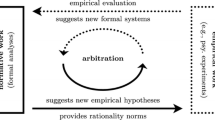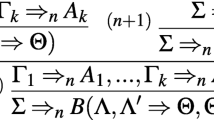Abstract
Nonmonotonic reasoning is often claimed to mimic human common sense reasoning. Only a few studies, though, have investigated this claim empirically. We report four experiments which investigate three rules of SYSTEMP, namely the AND, the LEFT LOGICAL EQUIVALENCE, and the OR rule. The actual inferences of the subjects are compared with the coherent normative upper and lower probability bounds derived from a non-infinitesimal probability semantics of SYSTEM P. We found a relatively good agreement of human reasoning and principles of nonmonotonic reasoning. Contrary to the results reported in the ‘heuristics and biases’ tradition, the subjects committed relatively few upper bound violations (conjunction fallacies).
Similar content being viewed by others
References
M.D.S. Braine D.P. O’Brien (Eds) (1998) Mental Logic Erlbaum Mahwah, NJ
G. Coletti R. Scozzafava (2002) Probabilistic Logic in a Coherent Setting Kluwer Dordrecht
R. DaSilva Neves J.-F. Bonnefon E. Raufaste (2002) ArticleTitle‘An Empirical Test of Patterns for Nonmonotonic Inference’ Annals of Mathematics and Artificial Intelligence 34 107–130
M. Ford D. Billington (2000) ArticleTitle‘Strategies in Human Nonmonotonic Reasoning’ Computational Intelligence 16 IssueID3 446–468 Occurrence Handle10.1111/0824-7935.00119
A. Gilio (2002) ArticleTitle‘Probabilistic Reasoning under Coherence in System P’ Annals of Mathematics and Artificial Intelligence 34 5–34 Occurrence Handle10.1023/A:1014422615720
R. Hertwig G. Gigerenzer (1999) ArticleTitle‘The “Conjunction Fallacy” Revisited: How Intelligent Inferences Look Like Reasoning Errors’ Journal of Behavioral Decision Making 12 275–305 Occurrence Handle10.1002/(SICI)1099-0771(199912)12:4<275::AID-BDM323>3.0.CO;2-M
S. Kraus D. Lehmann M. Magidor (1990) ArticleTitle‘Nonmonotonic Reasoning, Preferential Models and Cumulative Logics’ Artificial Intelligence 44 167–207 Occurrence Handle10.1016/0004-3702(90)90101-5
V. Lifschitz (1989) ‘Benchmark Problems for Formal Nonmonotonic Reasoning, Version 2.00’ M. Reinfrank J. Kleer Particlede M. Ginsberg (Eds) Nonmonotonic Reasoning Springer Berlin 202–219
B. Mellers R. Hertwig D. Kahneman (2001) ArticleTitle‘Do Frequency Representations Eliminate Conjunction Effects? An Exercise in Adversarial Collaboration’ Psychological Science 12 IssueID7 269–275
F.J. Pelletier R. Elio (2003) ‘Logic and Computation: Human Performance in Default Reasoning’ P. Gärdenfors J. Wolenski K. Kijania-Placet (Eds) In the scope of Logic, Methodology and Philosophy of Science, Vol. I Kluwer Dordrecht 137–154
Pfeifer N. (2002). ‘Poychological Investigations on Human Nonmonotonic Reasoning with a Focus on System P and the Conjunction Fallacy’. Master’s thesis Institut für Psychologie, Universtät Salzburg nikipfeifer@yahoo.de
L.J. Rips (1994) The Psychology of Proof: Deductive Reasoning in Human Thinking MIT Press Cambridge, MA
G. Schurz (1997) ‘Probabilistic Default Reasoning Based on Relevance and Irrelevance Assumptions’ D.e.a. Gabbay (Eds) Qualitative and Quantitative Practical Reasoning, No. 1244 in LNAI Springer Berlin 536–553
Schurz G. (2001). ‘Nichtmonotones Schließen: Ergebnisse einer empirischen Untersuchung’, Technical report, Institut für Philosophie, SFB F012 Forschungsmitteilungen, p. 17
A. Tversky D. Kahneman (1983) ArticleTitle‘Extensional versus Intuitive Reasoning: The Conjunction Fallacy in Probability Judgment’ Psychological Review 90 293–315
C. Vogel (1996) ‘Human Reasoning with Negative Defaults’ D. Gabbay H.J. Ohlbach (Eds) Practical Reasoning, Lecture Notes in Artificial Intelligence, 1085 Springer Berlin 606–621
Author information
Authors and Affiliations
Corresponding author
Rights and permissions
About this article
Cite this article
Pfeifer, N., Kleiter, G.D. Coherence and Nonmonotonicity in Human Reasoning. Synthese 146, 93–109 (2005). https://doi.org/10.1007/s11229-005-9073-x
Issue Date:
DOI: https://doi.org/10.1007/s11229-005-9073-x




